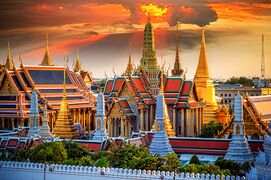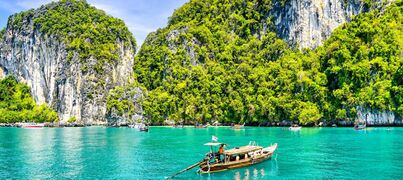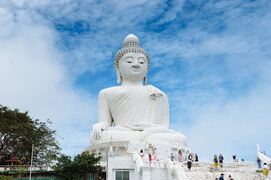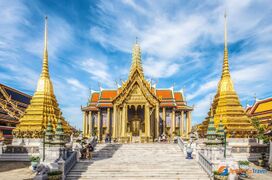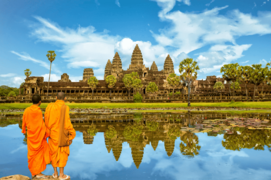Thervala: Difference between revisions
mNo edit summary Tags: Mobile edit Mobile web edit |
mNo edit summary |
||
| Line 58: | Line 58: | ||
|GDP_PPP=7,800}} | |GDP_PPP=7,800}} | ||
'''Thervala''' (Terwalaah), officially the '''Kingdom of Thervala''', is a constitutional monarchy in [[Audonia]]. It is neighbored by [[Oyashima]] | '''Thervala''' (Terwalaah), officially the '''Kingdom of Thervala''', is a constitutional monarchy in [[Audonia]]. It is neighbored by [[Oyashima]] and [[Metzetta]] | ||
Although the modern state that is the Kingdom of Thervala has only existed for a few centuries, people have been living in that region of Audonia since prehistoric times. Archaeological findings that date back to prehistory are sparse, but what has been found suggests that the prehistoric Ther people were a religious society, potentially theocratic in nature. It is also known that this prehistoric society subsisted largely off of trade and fishing. | Although the modern state that is the Kingdom of Thervala has only existed for a few centuries, people have been living in that region of Audonia since prehistoric times. Archaeological findings that date back to prehistory are sparse, but what has been found suggests that the prehistoric Ther people were a religious society, potentially theocratic in nature. It is also known that this prehistoric society subsisted largely off of trade and fishing. | ||
Revision as of 01:58, 31 July 2024
Thervala ("The Kingdom of Thervala") Ratcha-anachak Ther (Ther) | |
|---|---|
|
Flag | |
Motto: ชัยชนะด้วยเลือด ("Victory through blood") | |
Anthem: | |
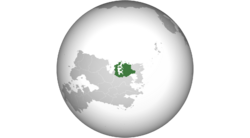 Location of Thervala (dark green) In Audonia (gray) | |
| Capital and largest city | Wat Kram |
| Official languages | Ther |
| Demonym(s) | Ther (noun) Ther (adjective) |
| Government | Constitutional Monarchy |
• King | Ananda Varma II |
• Prime Minister | Chatchai Suriyawan |
| Legislature | National Assembly |
| Senate | |
| House of Representatives | |
| Establishment | |
• Installment of the Varma Khram Dynasty | 03/25/1987 |
| Population | |
• Estimate | 80,000,000 |
| GDP (PPP) | estimate |
• Total | 7,800 |
| GDP (nominal) | estimate |
• Total | Your GDP = GDPPC x Population (This is calculated for you after first entry) |
• Per capita | Your GDP PC |
| Gini | Your gini coefficient Error: Invalid Gini value |
| Currency | Rathan (RTH) |
| Driving side | right |
Thervala (Terwalaah), officially the Kingdom of Thervala, is a constitutional monarchy in Audonia. It is neighbored by Oyashima and Metzetta
Although the modern state that is the Kingdom of Thervala has only existed for a few centuries, people have been living in that region of Audonia since prehistoric times. Archaeological findings that date back to prehistory are sparse, but what has been found suggests that the prehistoric Ther people were a religious society, potentially theocratic in nature. It is also known that this prehistoric society subsisted largely off of trade and fishing.
The borders of the Kingdom of Thervala have remained consistent since the forming of the original Vishran Dynasty. For a majority of its history, the kingdoms that have existed in the region that is now known as Thervala have either been ruled by foreign dynasties or vassalized under stronger foreign powers.
The earliest recorded state in the region was a Peshabi dynasty of nobles from the Arunid Empire known as the Vishran Dynasty that came to the Ther region of Audonia in 200 BCE. The Vishran Dynasty introduced written language and civilization to the indigenous Ther population. Much of ancient Ther culture is also linked to the Vishran Dynasty. This process is academically known as Arunidisation. The Vishran dynasty came to its eventual end due to the conquests of the Myanga Ayil Khanate. The capitulation of the Vishran Kingdom was largely bloodless, except for the Peshabi ruling class. This is because they became infamous for their hedonism and brutal style of ruling.
Because the indigenous ethnic Ther were collaborative with the Great Khan, a Ther dynasty was installed as a vassal under the Khanate in 1300 CE. This dynasty was known as the Khram dynasty and is responsible for the founding of the Kingdom's capital city, Wat Khram. This dynasty also issued edicts in regards to the development of the kingdom's civil and legislative codes and made the state religion Theravada Buddhism. Modern Thervala can also trace its martial culture to the Khram dynasty, as part of the vassalization required the Dynasty to provide the Khanate with a steady supply of well trained and well supplied troops to assist in the Khanate's conquest of Audonia.
The Khram dynasaty were loyal to the Khanate for centuries, largely due to the protection that was provided as well as the Khanate's laissez faire policy towards Ther self-determination and national identity. As conquests started to take a toll on the Ther population, a sentiment for independence began to develop. It wasn't until 1650 that the Khram dynasty came into contact with the Duchy of Martilles and the Martillien North Levantine Trading Company (MNLC). Upon establishment of diplomatic missions, the Khram dynasty was more than willing to act as a collaborative force against the now hated Khanate.
As a protectorate of the Duchy of Martilles, Thervala went through the process of Occidentalization, with the MNLC supplying and funding the Khram dynasty with state of the art arms and armor, as well as modernizing the Kingdom's administration. The Khram dynasty worked closely both with MNLC and the neighboring Yuganagawa Protectorate, administered by the Duchy of Marialianus' Ularien Trading Company, in battles against the Myanga Ayil Khanate. This close relationship with Maritime Dericania and their Oyashimane protectorate has influenced modern Ther culture immensely, with many loan words coming from Burgoignesc and Oyash.
Post-colonial era, the Khram Dynasty has kept a close relationship with Burgundie and has helped maintain Burgoigniac interests in Audonia, most notably in the war effort during Operation Kipling. During this time, Burgundie armed, trained, and funded the Kingdom's army. Due to the militarization of the country, a royalist, anti-communist military dictatorship was installed. Although, the king was still recognized as the head of state. This military dictatorship lasted until the late 1980s, when a military coup killed the dictator and defeated the loyalist faction within the military. A democratic, civilian government was installed but since then, the civilian government has changed hands multiple times through bloodless coups.
Currently, the Kingdom of Thervala is infamous for flagrant civil rights abuses due to intense legislation against free speech, because of its far reaching Lèse-majesté laws. The Kingdom is also renown for spending a majority of its GDP on its military and maintaining close military ties to Burgundie, most notably Ther marines train alongside the Burgoignac military on a Biannual basis.
Thervala is a member of the League of Nations.
Etymology
The Ther people are the indigenous ethnic group of Thervala, and in the Ther language “Ther” directly translate to “Person” or “People”. “Vala” in Ther is an honorific title meant to denote a holiness or purity. Thervala is then representative not only of the borders of the country itself, but also its people. The Land of the (Holy People).
History
Prehistoric Age
In prehistory, Thervala was comprised of small, religious tribes that lived in fishing communities in and around the East Audonian wetlands. A majority of what is known from this time period comes from bog bodies found in and around swamps near major pre-historic settlements. It is heavily theorized that these bog bodies are instances of ritual sacrifice.
Arunidisation
Ancient Thervala's history is predominantly that of the Vishran dynasties. These dynasties were kingdoms ruled by families originating from the Arunid Empire. This period is significant for introducing a written system, marking the earliest recorded history of Thervala.
The Peshabi princes, originally from Peshab, were dispossessed of their lands by the Pukhti royal family. The Pukhti sought to consolidate power and distributed these lands to their growing network of royal sycophants. Forced to seek new opportunities, the Peshabi princes traveled north, following the end of the trade routes, until they encountered the tribes of the Ther people. Demonstrating remarkable leadership and strategic acumen, the Peshabi princes united the Ther tribes under the banner of the Vishran dynasty, establishing a new era of governance and cultural development in Thervala.
Vassalization under the Myanga Ayil Khanate
Burgoignac Protectorate
Military Dictatorship
Modern Era
Geography
-
Wat Khram at sunset
-
Phin Krat, a popular tourist destination - the largest island in the inner Ther peninsula
-
The National Buddha of Thervala, located on the outskirts of Wat Khram
-
The Imperial Palace of the Khram Dynasty
-
Wat Vishran, the ancient capital of the Vishran Kingdom
Climate and environment
Thervala is a subtropical nation with a large amount of marshland on its mainland Audonian territory. A mountain range to its south makes up a natural border between The Kingdom of Thervala and its bordering nations. The central part of the nation is largely tropical and is comprised of the main Peninsula of Thervala which has over a thousand islands. In the southwest of the country is the Thrak'Tee river. The Thrak'Tee river flows from central Audonia all the way to Wat Khram.

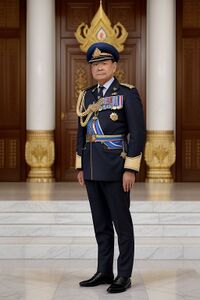
Government and Politics
The Kingdom of Thervala is governed by a de facto democratically elected civilian government but a de jure military government via majority seats in government.
Executive
The King of Thervala is largely a figurehead, but still retains a handful of executive functions and remains influential over the legislature. The main wielder of executive power in the country is the prime minister, who is an elected representative from the legislature. A majority of legislation drafted and passed by the legislature is written "in the interest" of the king.
Legislative
The legislative branch of the country is made up of an upper and lower house, which are comprised of elected officials from the various political parties of the country. Each political party elects a representative who will then run for the position of prime minister.
Federal subdivisions
The Kingdom of Thervala is comprised of ten provinces. These provinces' borders were created when the Khram dynasty was initially installed and are representative of the ten precepts of Buddhism. Each province is granted seventy seats in the Parliament.
Politics
Thervala has a handful of major political parties that ebb and flow in power. However, since the 1985 democratic coup, the ruling party has been the Royal party. The other major parties that have consistently held seats in the Ther parliament are the Fascist Party of Thervala (FPT), Thervala Social Democrat Party (TSDP), and the Green Party.
Law
Thervala is infamous the world over for its extremely harsh legal system. It employs torture of all kinds and has a sentencing rate of 97.5%. Prisons in the Kingdom of Thervala are also incredibly strict, regimented, and allegedly rife with human rights abuses. In Thervala, there is no separation between the military and law enforcement, they are one in the same. Thervala has an incredibly low crime rate due to its incredibly strict punitive measures.
Demographics
Ethnicity
Self-reported ethnic origin in the Kingdom of Thervala (2030)
What ethnic groups make up your country?
Language
Ther is the predominately spoken language in Thervala. Due to the kingdom's historic ties with Burgundie, Burgoignesc is a common second language as it is required by law to be taught in school. Oyash and Daxian are also spoken in Thervala, usually within immigrant communities.
Religion
Religious affiliations in the Kingdom of Thervala (2030)
The Kingdom of Thervala is a predominately Theravada Buddhist nation due to it being the state religion. However, there is a large Confucian base in the country from Daxian immigration. Also, due to Burgoignac influence, there is a sizable population of Mercantile Reform Protestants in the country.
Culture and Society
Education
The Kingdom of Thervala has compulsory school attendance. The government pays for both primary schooling and higher education. This process is based solely on merit, so higher education is incredibly competitive. Royal military personnel are virtually guaranteed a position within a Ther university post service.
Attitudes and worldview
The Kingdom of Thervala has a longstanding religious tradition and Theravada Buddhism is incredibly important to everyone - from the king to the common person. Due to Thervala's intense adherence to religion and stratified, monarchical society, it is known for being one of the most collective countries in the world. Each and every Ther citizen views themselves as having a role in society and they must perform their role to the best of their abilities. Because of this, military service is an incredibly esteemed profession and the Royal Military is never in short supply of new recruits.
Kinship and family
For the common person family is very important, a majority of people live in multi-generational households and even maintain close relations to distant family. For the upper class, there is a quasi-cast of nobility that has survived since the original Khram dynasty. There are many noble families that maintain high ranking positions within Ther society. There are even some Peshabi people alive today who can trace their ancestry back to the court of the Vishran Dynasty.
Cuisine
Ther cuisine is world renown for being incredibly delicious. This is because it has been influenced by Aruni, Oyashimane, Daxian, and Burgoignac cuisines. Ther food is known for being very spicy and flavorful, and employs traditional Burgoignac cooking techniques. Notable dishes include Ther Curry, Pad Ther, Krat Wi Dap, and Bahn Mip.
Religion
Theravada Buddhism is the state religion of Thervala and places the king in a position of holy authority. It is believed that the king must be a pious representation of the nation and to protect its religious interests at all costs. This view was instrumental in the installation of the wartime military dictatorship and the staunch anti-communist views that still permeate in the country.
Arts and Literature
Thervala has a rich history of poetry. This art was introduced to the Ther by the Peshab princes when the Vishran Dynasty was founded. There are a handful of Ther Epic Poems as well as a rich literary tradition pertaining to Buddhist mythology and tradition.
Economy and Infrastructure
Industries and Sectors
Thervala's economy is primarily sustained off of its entertainment industry as well as tourism. The tourist sector is largely divided between cultural tourism centered around Ther temples and red light tourism, due to the country's lax laws on prostitution and certain drugs.
Currency
The Ther currency is known as the Rathan. Bank notes are distributed in the 1,000, 1,500, 3000, 5000, and 10,000 denominations. As for coinage, there are 5, 10, 50, 100, 250, and 500 denominations. Bills are stylized with Ther kings on the face half and natural landmarks on the back half. Coins have the number on the face half and Buddhist monks or imagery on the tails half.
Healthcare
Healthcare is completely paid for by the King in Thervala as it is his religious duty to do so. This is only a domestic policy, though, and more advanced medical issues that are treated outside of the country must be paid for out of pocket. Such cases are usually treated in Oyashima.
Labor
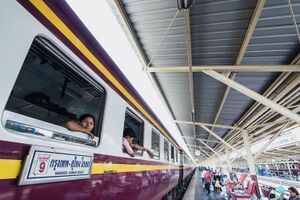
Labor unions are highly illegal in Thervala due to their association with socialist and communist movements. There are, however, very strict labor and safety laws that are enforced as much as possible. These are more prevalent in more urban areas, as rural areas do not have the administrative presence for such things to be enforced.
Transportation
The Kingdom of Thervala has a very comprehensive rail network, with access to each major city within the 10 provinces of the country. Within each city major city there are also large, extended urban metro lines. Designers and engineers were hired from Oyashima to help design these networks. Within the inner Ther peninsula, there is also a network of ferries dedicated to taking people between islands as well as to and from the mainland.
Technology
Thervala has historically had to rely on more advanced, foreign powers for its technological advancements. It is able to currently maintain a modern level of technology due to its proximity to Oyashima and close ties with Burgundie. Rural Thervala is incredibly technologically stagnant, though, and does not enjoy many of the luxuries of the Ther urban centers.
Military

The Kingdom of Thervala's military is a large and elite force. It has served alongside the Burgoignac military in every major armed conflict since the 1500's and has thus maintained a very experienced body of troops. It is the military's responsibility to act as law enforcement within the civilian sector as well as to protect the monarchy. The King and relatives of the king also precede over their own regiments within the military. Membership in such regiments is considered to be a highly esteemed honor.
Membership within the Ther military is highly sought after, due to its boons in regards to social mobility and education. Recruits are typically picked from high schools around the nation, and recruitment officers tend to make their decisions based off of academic merit as well as physical prowess. As such, high school sports teams tend to yield the highest amount of recruits into the military.
Officers within the Ther military are virtually all enlisted men that have served long enough to have enough experience for the role. There do exists programs within Ther universities for Officers to be recruited from student bodies. These officers, however, are few and far between.

